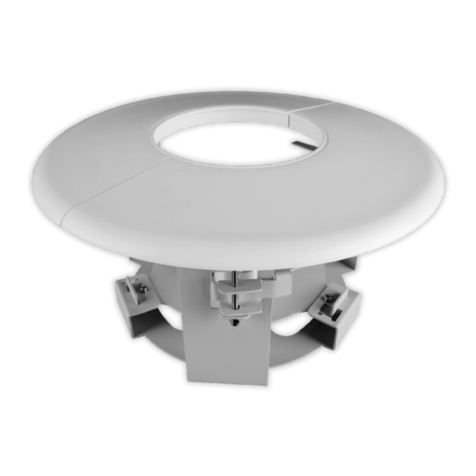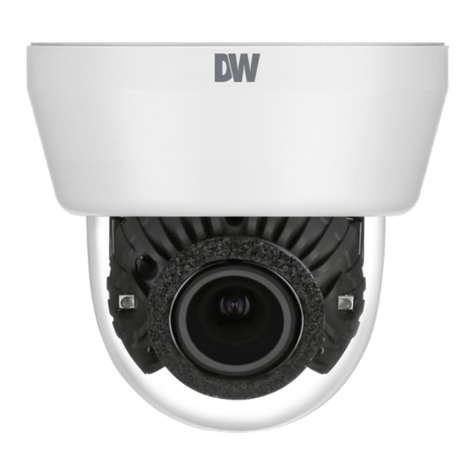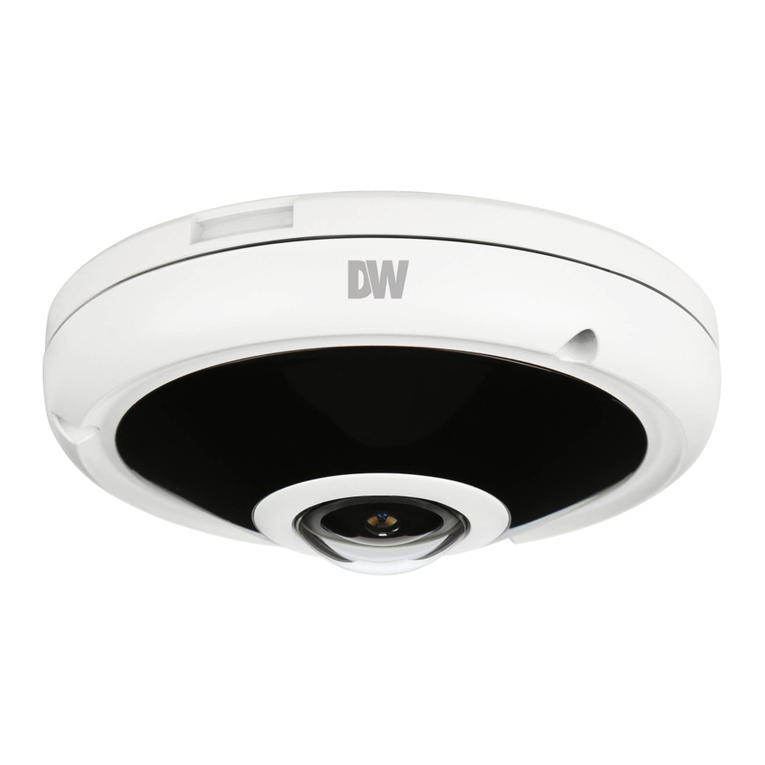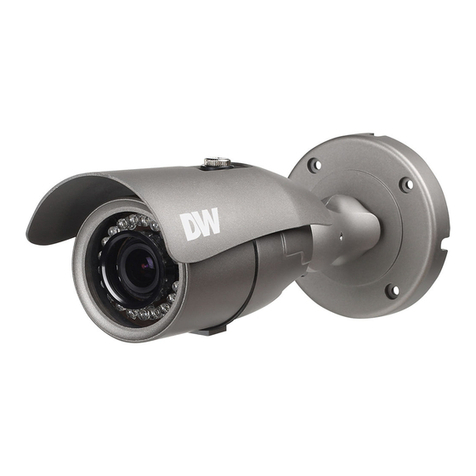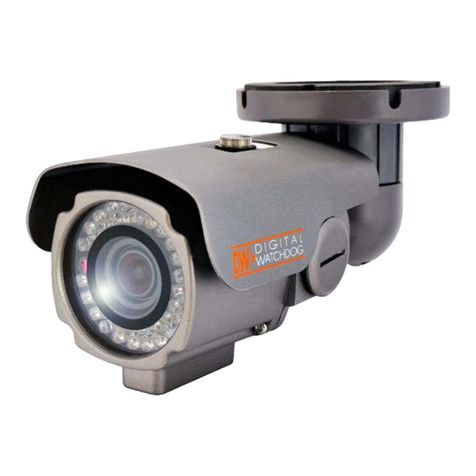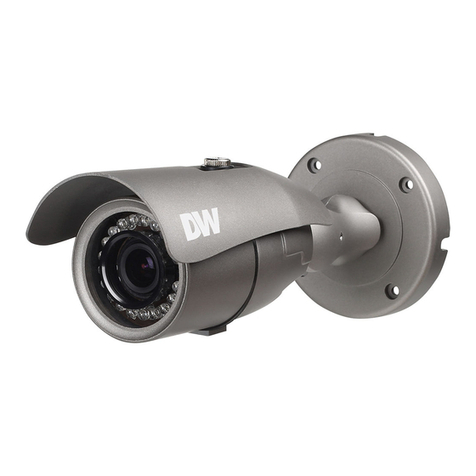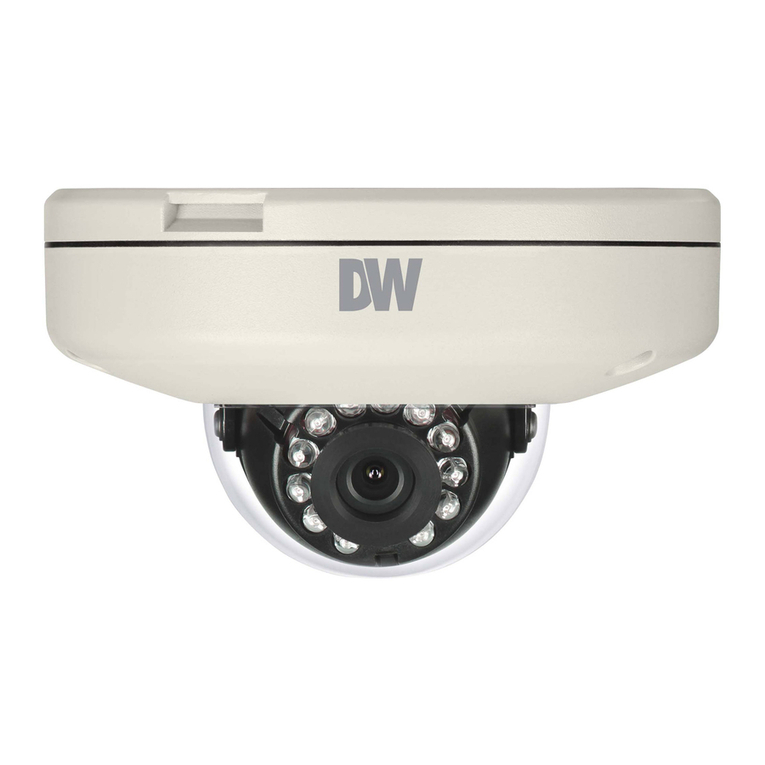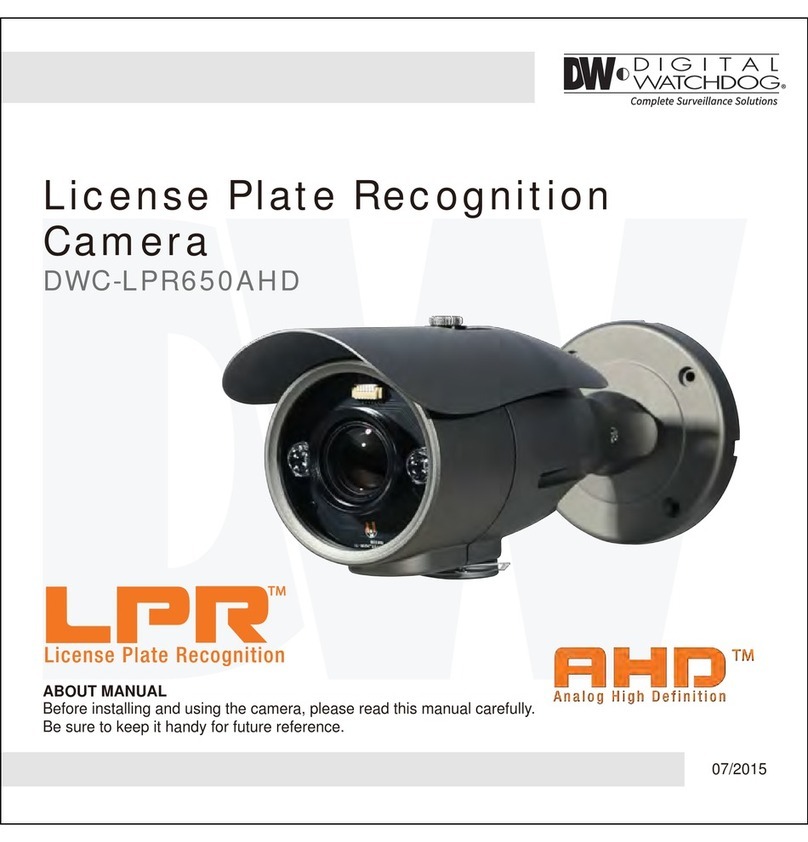
Quick Start Guide
Tel: +1 (866) 446-3595 / (813) 888-9555
Technical Support Hours:
9:00AM – 8:00PM EST, Monday through Friday
digital-watchdog.com
Attention: This document is intended to serve as a quick reference for the
initial setup. It is recommended that the user read the entire instruction manual
for complete and proper installation and usage.
NOTE: Download all your support materials and tools in one place.
1. Go to: http://www.digital-watchdog.com/resources
2. Search your product by entering the part number in the
‘Search by Product’ search bar. Results for applicable
part numbers will populate automatically based on the
part number you enter.
3. Click ‘Search’. All supported materials, including manuals
and quick start guide (QSGs) will appear in the results.
WHAT’S IN THE BOX
Quick Setup
Guide 1
Screws and
Plastic An-
chors – 4pcs
1 set
Mounting
Template 1Star Wrench
(T-20) 1
Test Video
Cable 1 DC Plug Cable 1
Waterproof Cap
and Rubber Rings
(Black: ø0.15”
(ø4mm), White:
ø0.19” (ø5mm))
1 set
Default login information
Username: admin Password: admin
DWC-MB44LPRC6 - 64GB storage
DWC-MB44LPRC1 - 128GB storage
DWC-MB44LPRC2 - 256GB storage
Test Video
Output
Reset Button
STEP 1 – PREPARING TO MOUNT THE CAMERA
STEP 2 – CABLING THE CAMERA TO
EXTERNAL DEVICES
1. The mounting surface must bear five times the weight of your camera.
2. Do not let the cables get caught in improper places or the electric line
cover to be damaged. This may cause a breakdown or fire.
3. CAUTION: These servicing instructions are for use by qualified service
personnel only. To reduce the risk of electric shock do not perform
any servicing other than that contained in the operating instructions
unless you are qualified to do so.
4. This product is intended to be supplied by a UL Listed Power Supply
Unit marked “Class 2” or “LPS” or “PS2” and rated 12 Vdc,
920 mA min.
5. The wired LAN hub providing power over the Ethernet (PoE) in
accordance with IEEE 802-3af shall be a UL Listed device with the
output evaluated as a Limited Power Source as defined in UL60950-1
or PS2 as defined in UL62368-1.
6. Unit is intended for installation in a Network Environment 0 as defined
in IEC TR 62102. As such, associated Ethernet wiring shall be limited
to inside the building.
7. Using the mounting template sheet or the camera itself, mark and
drill the necessary holes in the wall or ceiling.
Pass the wires through and make all necessary connections.
1. NETWORK CONNECTIONS – Using a PoE Switch or PoE Injector,
connect the camera using an Ethernet cable for both data and power.
2. NETWORK CONNECTIONS – Not using PoE Switch or PoE Injector,
connect the camera to the switch using an Ethernet cable for data
transmission and use a power adapter to power the camera.
Power requirements Power consumption
DC12V, PoE
(IEEE 802.3af class 3 )
(Adapter not Included)
DC12V Max 11W
PoE Max 12.9W
Quick Start Guide
STEP 3 – INSTALLING THE CAMERA
NOTE: Cables with ø4.5mm to ø5.5mm thickness should use
the black rubber ring. Cables over ø5.5mm in thickness
should use the white rubber ring.
1. Once all cables are connected, secure the camera to the mounting
surface using the included screws.
3. Loosen the pan and tilt screws at the base of the camera’s bracket to
adjust the camera’s view and position.
NOTE: To ensure moisture seal, make sure the o-ring is in
place between
a
and
b
. In extreme environments use
of an outdoor rated sealer is recommended.
a. Pass the LAN cable through the waterproof cap, gasket and
the rubber ring.
b. Connect the LAN cable to the camera’s network port .
c. will be axed to with a ¼ turn counter-clockwise.
d. Thread and twist tightly to .
a
b
b
dc
c
2. The waterproof cap set comes with two rubber rings with dierent
diameters. The black rubber ring has an internal diameter of ø0.15”
(ø4mm). The white rubber ring has an internal diameter of ø0.19”
(ø5mm). When using the waterproof cap, use the rubber ring best
suited for your network cable’s diameter.
THE CAPTURED IMAGE SHOULD BE FILLED WITH THE FULL WIDTH OF THE VEHICLES
THE CAMERA SHOULD BE MOUNTED AT AN ANGLE NO GREATER THAN 30 DEGREES
CAMERA ANGLE NO GREATER THAN 20 DEGREES FOR SIDE MOUNT INSTALLATIONS
>11.5ft
< 30°
< 20°
LPR INSTALLATION GUIDELINES
Resetting the camera: To reset the camera, use the tip of a
paper clip or a pencil and press the reset button. Pressing the
button for five (5) seconds will initiate a camera-wide reset of
all the settings, including network settings.
• The LPR camera should be mounted at a height between 3~8 ft., and
a distance no greater than 80 ft. from the target area. Exceeding
the distance recommendations may result in a poor quality image of
moving license plates.
• Ensure that the camera angle is no more than 20° degrees (horizontally)
30° degrees (vertically) from the target area.
• It is recommended to position a license plate or vehicle to reflect the
IR light of the camera while adjusting the camera’s focus of the target
area.
• After mounting the camera, you can press the Zoom Lens Button
(located on the underside of the camera) to sequentially zoom and
auto-focus the camera. Alternatively, the camera’s web GUI or
management software can be utilized as well. The longer the Zoom
Lens button (T-W jog button) is pressed down, the further the lens
module will zoom.
• Please note that the cameras ship with focus in Manual mode. To
change the camera’s focus to Auto, enter the camera’s web GUI and
use the +/- zoom buttons on the left of the camera image.
bc
d
a
Quick Start Guide
Tel: +1 (866) 446-3595 / (813) 888-9555
Technical Support Hours:
9:00AM – 8:00PM EST, Monday through Friday
digital-watchdog.com
Attention: This document is intended to serve as a quick reference for the
initial setup. It is recommended that the user read the entire instruction manual
for complete and proper installation and usage.
NOTE: Download all your support materials and tools in one place.
1. Go to: http://www.digital-watchdog.com/resources
2. Search your product by entering the part number in the
‘Search by Product’ search bar. Results for applicable
part numbers will populate automatically based on the
part number you enter.
3. Click ‘Search’. All supported materials, including manuals
and quick start guide (QSGs) will appear in the results.
WHAT’S IN THE BOX
Quick Setup
Guide 1
Screws and
Plastic An-
chors – 4pcs
1 set
Mounting
Template 1Star Wrench
(T-20) 1
Test Video
Cable 1 DC Plug Cable 1
Waterproof Cap
and Rubber Rings
(Black: ø0.15”
(ø4mm), White:
ø0.19” (ø5mm))
1 set
Default login information
Username: admin Password: admin
DWC-MB44LPRC6 - 64GB storage
DWC-MB44LPRC1 - 128GB storage
DWC-MB44LPRC2 - 256GB storage
Test Video
Output
Reset Button
STEP 1 – PREPARING TO MOUNT THE CAMERA
STEP 2 – CABLING THE CAMERA TO
EXTERNAL DEVICES
1. The mounting surface must bear five times the weight of your camera.
2. Do not let the cables get caught in improper places or the electric line
cover to be damaged. This may cause a breakdown or fire.
3. CAUTION: These servicing instructions are for use by qualified service
personnel only. To reduce the risk of electric shock do not perform
any servicing other than that contained in the operating instructions
unless you are qualified to do so.
4. This product is intended to be supplied by a UL Listed Power Supply
Unit marked “Class 2” or “LPS” or “PS2” and rated 12 Vdc,
920 mA min.
5. The wired LAN hub providing power over the Ethernet (PoE) in
accordance with IEEE 802-3af shall be a UL Listed device with the
output evaluated as a Limited Power Source as defined in UL60950-1
or PS2 as defined in UL62368-1.
6. Unit is intended for installation in a Network Environment 0 as defined
in IEC TR 62102. As such, associated Ethernet wiring shall be limited
to inside the building.
7. Using the mounting template sheet or the camera itself, mark and
drill the necessary holes in the wall or ceiling.
Pass the wires through and make all necessary connections.
1. NETWORK CONNECTIONS – Using a PoE Switch or PoE Injector,
connect the camera using an Ethernet cable for both data and power.
2. NETWORK CONNECTIONS – Not using PoE Switch or PoE Injector,
connect the camera to the switch using an Ethernet cable for data
transmission and use a power adapter to power the camera.
Power requirements Power consumption
DC12V, PoE
(IEEE 802.3af class 3 )
(Adapter not Included)
DC12V Max 11W
PoE Max 12.9W
Quick Start Guide
STEP 3 – INSTALLING THE CAMERA
NOTE: Cables with ø4.5mm to ø5.5mm thickness should use
the black rubber ring. Cables over ø5.5mm in thickness
should use the white rubber ring.
1. Once all cables are connected, secure the camera to the mounting
surface using the included screws.
3. Loosen the pan and tilt screws at the base of the camera’s bracket to
adjust the camera’s view and position.
NOTE: To ensure moisture seal, make sure the o-ring is in
place between
a
and
b
. In extreme environments use
of an outdoor rated sealer is recommended.
a. Pass the LAN cable through the waterproof cap, gasket and
the rubber ring.
b. Connect the LAN cable to the camera’s network port .
c. will be axed to with a ¼ turn counter-clockwise.
d. Thread and twist tightly to .
a
b
b
dc
c
2. The waterproof cap set comes with two rubber rings with dierent
diameters. The black rubber ring has an internal diameter of ø0.15”
(ø4mm). The white rubber ring has an internal diameter of ø0.19”
(ø5mm). When using the waterproof cap, use the rubber ring best
suited for your network cable’s diameter.
THE CAPTURED IMAGE SHOULD BE FILLED WITH THE FULL WIDTH OF THE VEHICLES
THE CAMERA SHOULD BE MOUNTED AT AN ANGLE NO GREATER THAN 30 DEGREES
CAMERA ANGLE NO GREATER THAN 20 DEGREES FOR SIDE MOUNT INSTALLATIONS
>11.5ft
< 30°
< 20°
LPR INSTALLATION GUIDELINES
Resetting the camera: To reset the camera, use the tip of a
paper clip or a pencil and press the reset button. Pressing the
button for five (5) seconds will initiate a camera-wide reset of
all the settings, including network settings.
• The LPR camera should be mounted at a height between 3~8 ft., and
a distance no greater than 80 ft. from the target area. Exceeding
the distance recommendations may result in a poor quality image of
moving license plates.
• Ensure that the camera angle is no more than 20° degrees (horizontally)
30° degrees (vertically) from the target area.
• It is recommended to position a license plate or vehicle to reflect the
IR light of the camera while adjusting the camera’s focus of the target
area.
• After mounting the camera, you can press the Zoom Lens Button
(located on the underside of the camera) to sequentially zoom and
auto-focus the camera. Alternatively, the camera’s web GUI or
management software can be utilized as well. The longer the Zoom
Lens button (T-W jog button) is pressed down, the further the lens
module will zoom.
• Please note that the cameras ship with focus in Manual mode. To
change the camera’s focus to Auto, enter the camera’s web GUI and
use the +/- zoom buttons on the left of the camera image.
bc
d
a
